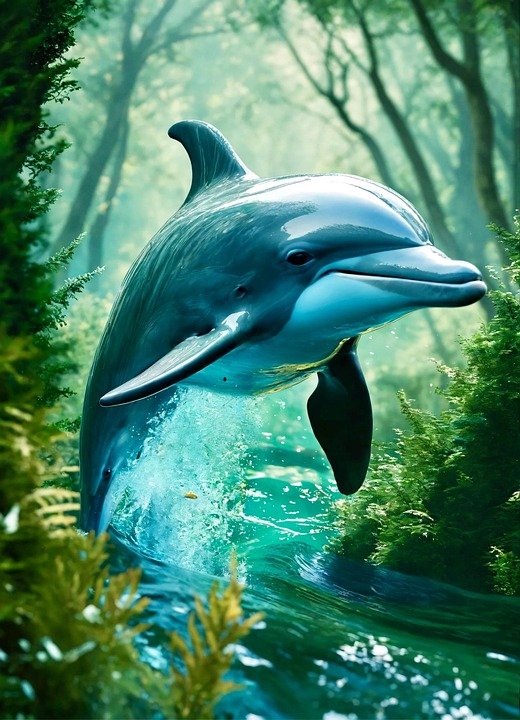
The journey of river dolphins begins millions of years ago and is intertwined with some pretty incredible evolutionary changes. From their ancient ancestors to their modern-day adaptations, understanding the evolutionary history of the river dolphin can reveal a lot about how life can adapt and thrive in diverse environments. Let’s dive into the depths of their story and explore how these remarkable creatures have evolved.
Ancient Ancestry: The Origins of Dolphins
To get a sense of where river dolphins come from, we need to travel back in time—way back, about 50 million years! Back then, dolphins were not the adorable, sleek creatures we know today. They were part of a larger group of animals called *Cetacea*, which also includes whales and porpoises. Their ancient ancestors were land-dwelling mammals that eventually made their way back to the water. This return to aquatic life set the stage for everything that followed.
During those early millions of years, dolphins evolved in various ways. They developed a streamlined body for efficient swimming, a blowhole for breathing at the water’s surface, and, importantly, echolocation to help them navigate and hunt in dark waters. This ability is like having a built-in sonar system—super useful for finding food and avoiding obstacles.
As time went on, not all dolphins followed the same path. Some went into saltwater environments like oceans, while others ventured into freshwater rivers and lakes. This is where the story of river dolphins really starts to take shape.
Distinct Species: The River Dolphins of Today
Today, there are five distinct species of river dolphins, each adapted to its specific habitat. These include the Amazon river dolphin, the Ganges river dolphin, the Indus river dolphin, the Yangtze river dolphin, and the Boto. Let’s take a closer look at a few of them.
- Amazon River Dolphin: Known for their pink hue, these dolphins are often spotted in the Amazon River. They have a robust body and a flexible neck, allowing them to maneuver easily among obstacles in their environment.
- Ganges River Dolphin: Famous for its unique sonar abilities, this species resides in the freshwater rivers of India, Bangladesh, and Nepal. It’s one of the few dolphins that cannot see well, relying heavily on echolocation.
- Yangtze River Dolphin: Also known as the Baiji, this dolphin was once abundant in China’s Yangtze River but is currently critically endangered. Its plight highlights the importance of conservation efforts.
These species have evolved specific traits to help them thrive in freshwater. For instance, river dolphins typically have a more elongated snout compared to their oceanic cousins. This helps them reach fish and other prey hiding in the mud or beneath plants. Their adaptations are a beautiful example of how life can change over time in response to different environments.
Life in Freshwater: Unique Adaptations
Life in rivers presents some unique challenges, and river dolphins have developed a range of adaptations to survive. For starters, freshwater habitats can be murky and filled with obstacles such as logs and rocks. River dolphins have evolved enhanced echolocation abilities that allow them to “see” their surroundings through sound. This skill is crucial in locating prey as well as navigating through their often-complex environments.
Another adaptation is their flexible bodies. Unlike ocean dolphins, which are more streamlined, river dolphins often have wider bodies and long, thin snouts. This design helps them maneuver through tangled underwater vegetation. They are also known for being less social than oceanic dolphins, often preferring solitary or small group living. This may help them avoid competition for food in their limited habitats.
Additionally, river dolphins have relatively small dorsal fins. While ocean dolphins have tall fins that help them stabilize in choppy waters, river dolphins don’t need such features in the calmer rivers. This adaptation helps them glide through the water quietly, making them stealthy hunters.
Lessons from the River Dolphins’ Journey
The evolutionary history of river dolphins serves as a fascinating chapter in the larger story of adaptation and survival. It reveals how species can diverge significantly from their ancestors based on their environment. River dolphins remind us that evolution is not just about survival of the fittest but also about survival in the most unexpected places.
Their journey through the ages brings to light critical lessons for us today, especially about how changes in our environment—like pollution, damming rivers, and climate change—can threaten these unique creatures. Understanding their evolution helps us grasp why they are so vulnerable and why we should care deeply about their preservation.
Conservation Challenges: Protecting River Dolphins
Sadly, river dolphins face numerous threats in our modern world. Pollution, habitat loss, and accidental entanglement in fishing gear are just a few of the significant challenges they face. Conservationists are actively working to protect these animals but it takes a community effort.
For example, the Yangtze River dolphin has seen a drastic decline and is now functionally extinct. Protecting river dolphins requires not just laws but also community involvement and education about the importance of these creatures. Simple actions, like reducing plastic use and advocating for clean waterways, can help make a difference.
By understanding the evolutionary history of river dolphins, we can appreciate their role in ecosystems and the urgent need for their protection. They are more than just animals living in the river; they are vital parts of the natural world that we must strive to protect.
The story of river dolphins is a powerful reminder of how life adapts, changes, and finds ways to thrive against the odds. From their ancient ancestors to the specialized adaptations we see today, they showcase the sheer resilience of nature. Their evolutionary journey is both captivating and sobering, especially as they navigate the modern threats posed by human activity.
As we think about river dolphins, it’s essential to embrace their legacy. They deserve our attention and respect. By learning about their history, we not only increase our knowledge but also our commitment to ensuring that these incredible creatures remain a part of our world for generations to come. So the next time you think about dolphins, remember—there’s a lot more under the surface than you might expect!

